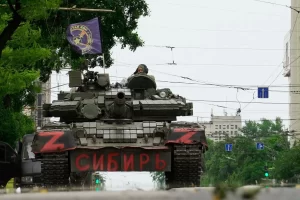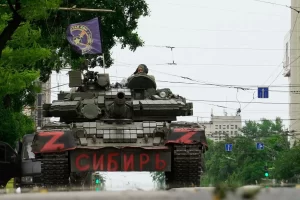We are sharing with our readers “Big Serge’s” reflections on the Wagner mutiny affair not because it is long and tedious (which it is) but because it incidentally makes many good points and stimulates critical reflection while sifting through the leading explanatory theories that have been advanced. The commentariat’s need to impress with quick-witted explanations is understandable, but it should always be restrained, at least until there is sufficient data to justify venturing a unified field theory. We would offer the same advice to Pepe Escobar.
But with all the attractions of his analysis, Big Serge circumvents what we consider to be the key issue: how and why did a sleazy character like Prigozhin come to be selected to play over the years on behalf of the Russian state the significant role that had apparently been assigned to him? Larry Johnson believes that the security agencies that were running Prigozhin failed to supervise him properly, which seems to be true enough. But why Prigozhin in the first place and not some decent, trustworthy Russian patriot? The ultimately depressing answer to that crucial question will tell us a great deal about the current condition of “Deep Russia”.
The events of the past weekend (June 23 – 25, 2023) were so surreal and phantasmagorical that they militate against narration and defy description. On Friday, the infamous Wagner Group launched what appeared to be a genuine armed insurrection against the Russian state. They occupied portions of Rostov on Don – a city of over 1 million people, regional capital, and headquarters of Russia’s Southern Military District – before setting off in an armed column towards Moscow. This column – replete with heavy military equipment including air defense systems – came within a few hundred miles of the capital – virtually unmolested by Russian state forces – before abruptly stopping, announcing that a deal had been brokered with the aid of Belorussian President Aleksandr “Uncle Sasha” Lukashenko, turning around, and heading back to Wagner bases in the Ukrainian theater.
Needless to say, the spectacle of a Russian mercenary group making an armed march on Moscow, and of Wagner tanks and infantry cordoning off Ministry of Defense buildings in Rostov, sparked widespread confidence among the western commentariat that the Russian state was about to be toppled and the Russian war effort in Ukraine would evaporate. There were confident and outlandish predictions pushed out in a matter of hours, including claims that Russia’s global footprint would disintegrate as the Kremlin recalled troops to defend Moscow and that Russia was about to enter a state of Civil War. We also saw the Ukrainian propaganda machine kick into overdrive, with characters like Anton Gerashchenko and Igor Sushko absolutely bombarding social media with fake stories about Russian army units mutinying and regional governors “defecting” to Prigozhin.
There’s something to be said here about the analytic model that prevails in our time – there’s a machine that instantly springs to life, taking in rumors and partial information in an environment of extreme uncertainty and spitting out formulaic results that match ideological presuppositions. Information is not evaluated neutrally, but forced through a cognitive filter that assigns it meaning in light of predetermined conclusions. Russia is *supposed* to collapse and undergo regime change (Fukuyama said so) – therefore, Prigozhin’s actions had to be framed in reference to this assumed endgame.
On the opposite end of the spectrum, we saw some similar measure of aggressive model-fitting from “Trust the Plan” Russia supporters, who were confident that the Wagner uprising was just an act – an elaborate ruse concocted in concert by Prigozhin and Putin to fool Russia’s enemies and advance the plan. The analytic error here is the same – information is parsed only for the purpose of buttressing and advancing a pre-concluded endgame; except it is Russian omnicompetence which is assumed instead of Russian state collapse.
I took something of a middle view. I found the idea that Russia faced civil war or state collapse to be bizarre in the extreme and completely unfounded, but I also did not think (and I feel that events have vindicated this view) that Prigozhin was acting in collaboration with the Russian state to create a charade. If indeed the Wagner uprising was a Psyop (Psychological Operation) to trick NATO, it was an extremely elaborate and convoluted one which hasn’t yet shown any clear benefits (more on this in a moment).
My broad belief is that Prigozhin was acting of his own volition in an extremely risky way (which risked both his own life and a destabilizing effect on Russia). This presented the Russian state with a genuine crisis (albeit one which was not sufficiently severe to threaten the state’s existence) which I think they handled quite well on the whole. The Wagner uprising was quite clearly bad for Russia, but not existentially so, and the state did a good job containing and mitigating it.
Let’s get into it, starting with a short look at the timeline of events.
Anatomy of a Mutiny
The amount of disinformation (particularly propagated by the Ukrainians and by Russian liberals residing in the west) that flew around throughout the weekend was extreme, so it might be prudent to review the progression of events as they actually happened.
The first sign that something was amiss came with a few explosive statements by Wagner head Yevgeny Prigozhin on the 23rd (Friday). In a rather long and erratic interview, he made the shocking claim that Russia’s pretext for the war in Ukraine was an outright lie and that the war had been fraught with corruption and the murder of civilians. Things then got even crazier when Wagner claimed that the Russian army had struck their camp with a missile. This was extremely weird – the video which was released (purporting to show the aftermath of this “missile strike”) did not show an impact crater, debris, or any wounded or killed Wagner personnel. The “damage” from the missile consisted of two campfires burning in a trench – apparently Russia has missiles that can start small controlled fires without destroying the surrounding plant life?
The video obviously did not show the aftermath of a missile attack, but Prigozhin’s rhetoric escalated after this and he soon announced that Wagner would begin a “march for justice” to gain redress for his various grievances. It was not clear exactly what he wanted, but it seemed to center on personal grudges against Minister of Defense Sergei Shoigu and Chief of the General Staff Valery Gerasimov.
Shortly thereafter, a few videos came from the Russian authorities (including one featuring General Surovikin) apparently pleading with Wagner to “stop the movement of their columns” and return to their posts, to prevent bloodshed and destabilization. This validated some of the rumors that Wagner was leaving the theater in force. News that Russian National Guard had been activated in Moscow and elsewhere seemed to vindicate the fear that an armed clash in Russia was imminent.
By the end of Friday, armed Wagner convoys were in Rostov (bearing the red Z mark) and had taken control of several military offices in what amounted to a bloodless coup of the city. The scenes were a bit outlandish – tanks on the city streets and security cordons around key facilities, but seeming indifference from the population. People mingled among the Wagner troopers, street sweepers went about their work, Wagner bought cheeseburgers, and people took pictures with the tanks.
Things really got heated the next day (Saturday the 24th) with the news that two substantial armed bodies were on the move within the prewar Russian borders. One was a column of Wagner personnel and weapons who left Rostov for Moscow, and other was a Chechen force dispatched by the state to Rostov. Amid the news that Russian state forces were establishing roadblocks and defensive positions outside of Moscow, it looked like two separate battles might have been imminent – one by the Wagner column fighting state forces outside Moscow, and another fought between the Chechens and the Wagner remnants for control of Rostov.
It was at this point that Ukrainian disinformation really began to run wild, with claims flying around that Russian military units and regional administrations were defecting to Prigozhin – in effect positing that this was not just an uprising by Wagner against the state, but a wholesale revolt of the Russian system against Putin’s government. In fact (and this is a key point to which I will return later) there were no defections in any regular Russian military units or regional governments and there was no civil unrest. The mutiny was confined to the Wagner Group, and even so not all of Wagner participated.
Be that as it may, by the early evening hours on Saturday there were real reasons to worry that shooting might start outside Moscow or in Rostov. Putin issued a statement denouncing treason and promising an appropriate response. The Russian Ministry of Justice opened a criminal file on Prigozhin for treason. Two Russian MoD aircraft were shot down (an Mi-8 helicopter and an IL-22) by the Wagner column. The global atmosphere became notably more humid from the volume of salivation flowing from Washington.
For the rest of the article, please go directly to Big Serge’s website:
https://bigserge.substack.com/p/russo-ukrainian-war-the-wagner-uprising




